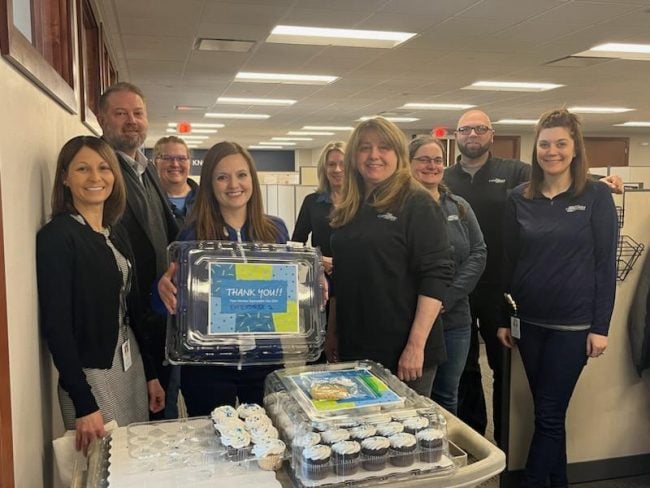When a 2013tornado demolished the $3.2 billion Tinker Federal CreditUnion's branch in Moore, Okla., a vault encased in concrete savedthe lives of employees and members.
|A security vault was also the only thing left standing after a2011 fire destroyed an Augusta, Ga. branch of Augusta VAH FederalCredit Union and three years after the destruction, the $62million, Martinez, Ga.-based cooperative broke ground on a new6,000-square-foot branch.
|It's been six years since a 5.5-magnitude earthquake devastateda historic Los Angeles building that housed a branch that belongedto the $618 million SEC Federal Credit Union, which is based inIrwindale, Calif. After the city remodeled the damaged building,the Boyle Heights reopened branch this summer.
|Natural disasters, such as floods and blizzards, haveillustrated the importance of disaster preparedness and contingencyplanning for credit unions.
|With hurricane season still in full swing, winter storms rightaround the corner and Ebola victims in the news, it's imperativefor credit unions to ensure they have proper protocols in place tohandle catastrophes of any kind, according to CUNA MutualGroup.
|“You need to know what types of natural disasters could possiblyoccur in your area and devise a contingency plan for eachscenario,” Jim Hunt, staff underwriting specialist for CUNA MutualGroup, said .“Not only do you have to plan for Mother Nature, butalso for man-made disasters.”
|Cyberattacks, terrorism, pandemics and deranged people are amongthe newest threats facing credit unions, he said. Not only canbeing prepared possibly save lives and prevent disruption ofservice to members, it can enable cooperatives to lower propertyand business liability costs, Hunt noted.
|Read more: CUNA Mutual reports 400 disaster claimslast year …
|But are credit unions ready, willing and ableto respond during a crisis and do they have business continuity andrecovery plans in place to bounce back quickly? The statisticsregarding disaster preparedness and recovery are almost as scary asthe potential threats.
|Last year, CUNA Mutual said it received more than 400 claimsfrom credit unions for damage related to fire, wind, hail andwater.
|Unfortunately, only about half of U.S. businesses haveimplemented an adequate disaster recovery plan and more than 40% ofbusinesses closed by a natural disaster never reopen, according tothe U.S. Department of Labor.
|Hunt pointed out that emergencies don't have to be HurricaneSandy-sized to qualify as a disaster. Water main breaks or frozenpipes can put credit unions out of commission and in the crosshairsof regulators who have strict business resumption guidelines, hesaid.
|Maintaining insurance coverage is a critical component of any disasterpreparedness plan that is often overlooked by organizations, Huntsaid.
|Credit unions should review their insurance to determine ifsufficient coverage is in place to repair damages, replaceequipment and rebuild facilities, when necessary.
|“You might have to find different ways to serve members such asbringing in a trailer or renting a space, which will mean you alsohave extra security costs,” he said.
|Hunt said he has encountered many cases where credit unionssuffered by having inadequate insurance.
|Nearly 20% of cooperatives insured by CUNA Mutual areunderinsured by at least 20% and almost 25% are over-insured by20%, the agency said.
|In one case, a credit union's two-story building was destroyed,but the institution did not have enough coverage to rebuild afacility of the same size, Hunt said.
|“They were only able to put up a one-story building,” he added.“That's why it pays to review your insurance coverage on a regularbasis.”
|Determining the right deductibles is also imperative, Huntsaid.
|“Credit unions like the lowest deductible possible, which isunderstandable, but you have to consider a lot of factors,” heexplained. “I've had credit unions executives that carried higherdeductibles on their homes, than on their credit unions.”
|Read more: Insurance best practices…
|Credit unions should budget between $1 and $2per member per year on disaster recovery solutions to offset theirrisk, Kirk Drake, founder/CEO of Ongoing Operations, a disasterrecovery services CUSO in Hagerstown, Md., said.
|“This more than pays for itself,” he noted. “The funds should beallocated between insurance, data backup, hot site and workspacesolutions, business continuity plans, etc., based on a combinationof probability and impact to determine whether they should spendmore on insurance versus technology versus process.”
|To lower premiums, Drake advised credit unions to focus onfinding ways to remove single points of failure in the technologyplatform, ensuring FFIEC guidelines are followed and having abusiness impact analysis, risk analysis and plan, to figure out thebest coverage.
|Credit unions should closely review additional coveragesincluded in policies for things such as debris removal or coveragefor signs and landscaping, Rock Carter, president/CEO of The Rock Group, a vendormanagement firm in Salt Lake City, said.
|“These generally can be good coverages, offered at a veryreasonable cost by most credit union carriers, but you really needto understand what you have,” he explained.
|Carter said credit unions that want to lower premiums canmaintain higher deductibles, eliminate certain coverage, switch toa catastrophic or reinsurance option that only covers massivedamage, or maintain self-insurance, which is a risky propositionand only appropriate if a credit union has adequate reserves forany possible loss.
|“As with all insurance, it is good to strike a balance betweenthe cost of the insurance and the likelihood of an insured event tooccur,” Carter suggested. “It is all about your appetite foraccepting risk versus sharing risk with an insurance provider andthe potential impairment of your reserves due to a non-coveredloss.”
|CUNA Mutual advised credit unions on how they can adjust limitsand deductibles to maximize and, in some cases, lower their premiumdollars paid, Hunt said.
|Cooperatives must draft business continuity and data recoveryplans so they can continue to function and bounce back quicklyafter catastrophic events. He also advised credit unions to includeall staff members in various phases of the planning process.
|“Get the group together and brainstorm so you don't missanything,” he said. “Employees are the most important asset of acredit union. So, protecting them must be a priority and one personcan't think of everything.”
|A communication plan is essential to reassure members, staff andother stakeholders.
|“You also have to make sure that all employees know the detailsof the plan and what their role will be during an emergency,” Huntsaid, who recalled an incident during Hurricane Sandy.
|“All the executives and board members of the credit union wereout of state at a conference when Sandy hit,” he said. “So, youhave to make sure all employees know how to implement theplans.”
|Credit unions should conduct fire drills, tornado drills andother preparedness training, Hunt said.
|“If you have a plan, but you don't test it, then you reallydon't have a plan in place,” he cautioned.
|Hunt also suggested that credit unions contact a local orregional disaster office, fire department and other agencies fordisaster preparedness plans related to their area.
Complete your profile to continue reading and get FREE access to CUTimes.com, part of your ALM digital membership.
Your access to unlimited CUTimes.com content isn’t changing.
Once you are an ALM digital member, you’ll receive:
- Critical CUTimes.com information including comprehensive product and service provider listings via the Marketplace Directory, CU Careers, resources from industry leaders, webcasts, and breaking news, analysis and more with our informative Newsletters.
- Exclusive discounts on ALM and CU Times events.
- Access to other award-winning ALM websites including Law.com and GlobeSt.com.
Already have an account? Sign In
© 2024 ALM Global, LLC, All Rights Reserved. Request academic re-use from www.copyright.com. All other uses, submit a request to [email protected]. For more information visit Asset & Logo Licensing.









